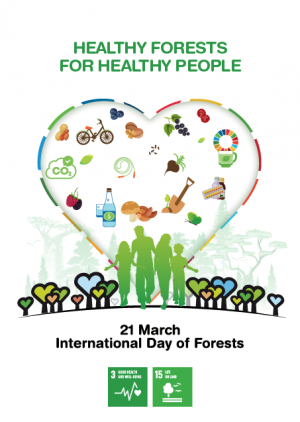While many of us have taken pain relievers, we do not always remember that one of the most extensively used medicines in the world – with an estimated annual consumption of 40,000 tons – salicylic acid, commonly known as aspirin, is based on a tree-derived ingredient.
The theme of this year’s International Day of Forests – “Forests and Health” – aims to emphasize how forests provide, prevent and heal. They purify the water we drink, clean the air we breathe, improve our mental health, provide us with healthy food, and are a source of life-saving medicines. Forest plants have long been used as herbal and traditional remedies, and their chemical compounds are helping fight some of the world’s deadliest diseases.
The United Nations estimate that 25% of medicinal drugs used in developed countries are plant-based, while in developing countries, it can be as much as 80%. And while many of these medicines are developed by chemists and biologists in laboratories, where they isolate the plants’ active agents and replicate them synthetically, many of our essential drugs originate in woodlands.
UNECE’s “Forests as Pharmacy” campaign aims to put a spotlight on forestland as an invaluable source of plant-based medicines for the treatment and/or prevention of noncommunicable diseases (NCDs). Also known as chronic diseases, NDCs are not passed from person to person. They tend to be of long duration and are the result of a combination of genetic, physiological, environmental and behavioural factors. Each year, NCDs kill 41 million people, with four types accounting for over two thirds of premature deaths – cardiovascular diseases, cancers, chronic respiratory diseases, and diabetes. Research has proven that some plant-based drugs from the forest lands can help reduce the risk of contracting and/or treat NCDs, in particular:
-
Cardiovascular diseases: In the bark of the white willow originates salicin, an active component which, when converted to salicylic acid through metabolism, helps prevent cardiovascular diseases, including myocardial infarction and strokes;
-
Cancer: Paclitaxel, the most well-known plant-derived cancer drug in the United States, is extracted from the Pacific yew tree and is mostly used in the treatment of breast, lung, and ovarian cancer, as well as Kaposi’s sarcoma.
-
Respiratory diseases: Radix senegae, an agent originating in the dried roots and crowns of the Seneca snakeroot, is used to treat inflammations of the throat, nose, and chest and for lung conditions including asthma, chronic bronchitis and emphysema.
Forests are medical treasure chests that can provide us with new remedies and cures. But for that to happen, we need to keep them healthy, biodiverse, and productive, which is why responsible, long-term management of forests is so important. Once forests are removed, their benefits, such as biodiversity and water filtration, can hardly be recovered. Only if we care for our forests, will our forests continue to be able to care for us.
Find a UNECE’s visual overview of medicines from the forest on our dedicated site.


